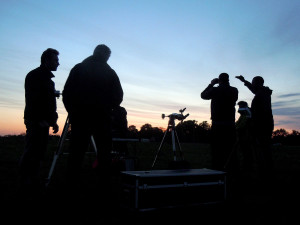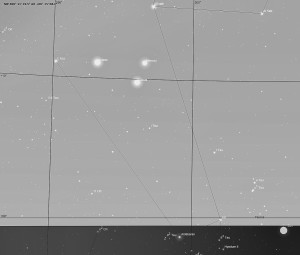May 25, 2013
Blackheath “Stargazing” Evening – Saturday 25 May
Report by: Mike Meynell
Torrential rain for most of Friday 24 May put paid to any plans that we had for running a Blackheath stargazing session on Friday evening and so an early decision was made to move the session to Saturday. This proved to be a prescient move, as the weather for most of Saturday was glorious and clear skies greeted us as we arrived at Blackheath at around 7pm in the evening. Rupert and I had decided to set up early in order to do some solar viewing for an hour or so, before the main ‘stargazing’ session started at 9pm. My scope was fitted with astro solar film, in order to view the Sun in ‘white-light’, giving some wonderful views of several sunspots visible on the solar photosphere. Rupert opted for using a Hershel wedge, a device fitted at the eyepiece end of the scope, rather than the objective end, which uses a prism to refract 95% of the light and heat. Used in conjunction with an appropriate neutral density filter, this provides beautiful high-contrast views of the Sun in white-light.
As it was still daylight, several passers-by stopped to see what we were up to. In every case, it was the first time that the person had viewed the Sun through a telescope and all were absolutely astonished by the detail that could be seen. It’s moments like these that make all the organising of these events worthwhile… I often judge the success of an event based on the number of “wow’s” that are heard from people looking through the telescope and, on that basis, this evening was a resounding success!
With the Sun setting in the north-west, we turned our attention to the close conjunction of Jupiter, Mercury and Venus, which were about 10-degrees above the horizon at 9pm. This close conjunction of the 3 planets at the end of May 2013 would not be seen again until 2021, so we were keen to get a good view. We were not disappointed. Shortly after sunset, telescopes and binoculars were pointed to the north-west horizon and it wasn’t long before Venus was spotted, with Mercury soon spotted less than 2-degrees away. Moving just 3-degrees to the east of Mercury, we spotted Jupiter very easily. A wonderful sight to witness and we spent the next 45 minutes or so happily slewing between these 3 planets, before they disappeared in the murk over Central London.
By this stage, several people had arrived to participate in the event and we probably had around 40 people turn up during the course of the evening. The Full Moon started to rise in the south-east and looked incredibly eerie, as some low light cloud partially obscured the lunar disc and turned the visible colour orange-red. Whilst we waited for the Moon to rise further, we focussed on an object that, in my view, is unsurpassed in the night-sky: the planet Saturn. The “wow’s” went into overdrive at this point! Queues developed at the telescopes as attendees were keen to see this jewel of the Solar System. Several Saturnian moons were visible, which added to the excitement, with Titan particularly prominent.
By 11pm, people were starting to drift away, so we decided to pack up the scopes and head home. Perhaps “stargazing” was a misnomer on this occasion, as our focus was on Solar System objects, but, whatever we called it, everyone had a thoroughly good time. Our next scheduled Blackheath “Stargazing” session is not until September, as we enter the end of season period. However, we are likely to call some short-notice events, both at Blackheath and Cudham, over the summer period. Keep an eye on the website for more information.
As a side note, viewing Venus and Mercury over several nights gives you a real sense of the celestial motion of the planets. The next evening, I found myself by the coast in Whitstable, where I took this photograph. Even in the space of 24 hours, Mercury had moved significantly eastwards, with Venus also much closer to Jupiter. As I viewed the night sky yesterday evening (2 June), I saw Mercury, Venus and Jupiter all strung out in a line, now about 8-degrees apart.
Mercury reaches maximum elongation from the Sun on 12 June, so now is fabulous time to see this elusive object just after sunset. Jupiter, sadly, will be disappearing from our skies quite soon, as it passes through superior conjunction. Venus, however, will be visible in our evening skies for the entire Summer, low in the west just after sunset. Just don’t mistake it for a UFO!
Pictures (slideshow) from the Event (by Grey Lipley):
Posted under: Blackheath, Flamsteed, Meeting Report, Stargazing



You must be logged in to post a comment.